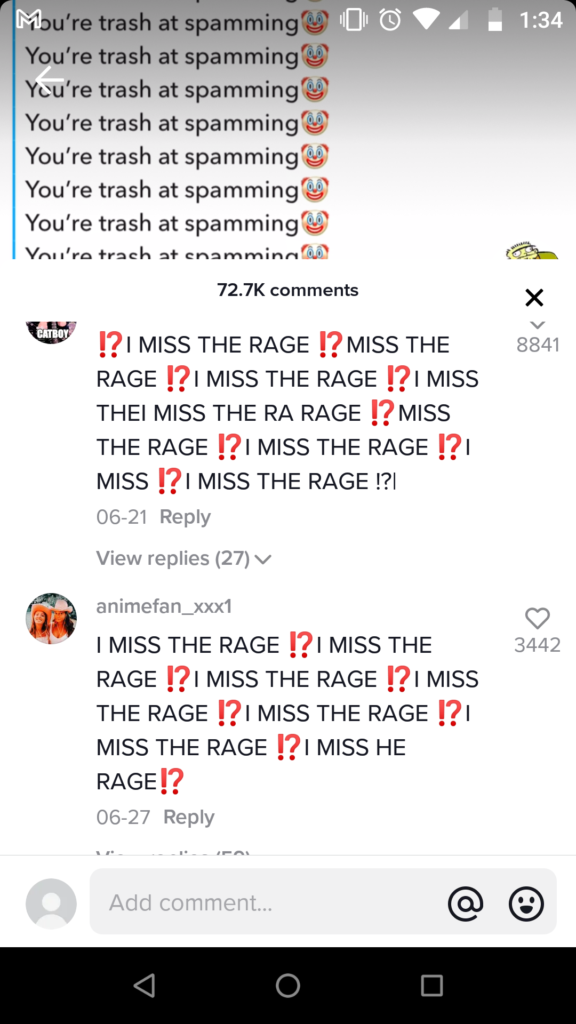Games
The early 2010s was an era of mobile-gaming greats, with such classics as “Where’s My Water?” and “Cut the Rope” appearing on millions of smartphones. ‘Thingamajig’ style apps started appearing: these are the apps that allow you to interact with a single character or device on-screen, usually with a limited set of tools.
The more complex ones were like Talking Tom, a cat character who you could smack and give cake to. Talking Tom could also repeat things you said into the microphone, which made him very popular. The next generation of these ‘Talking X’ characters included Angela, who, unlike Tom, had a typed chat feature. She couldn’t generate her own replies, but she could give responses from a pre-made library that were roughly relevant to what the player had typed. The AI was fairly simple, but it kept kids entertained, and that was good enough. The app was PG-E with a child mode because it had in-game purchases. Naturally, the content was pretty tame even with child mode off.
It did ask questions about the user’s name and age as well as conversational topics, but that was with that child mode off. In the event that a parent forgets to set child mode to ‘on’ or the kid gets around it, Angela still couldn’t ask anything invasive. Her AI gave her pre-made responses, she couldn’t ‘learn’ beyond adding player inputs to her answers. There was just no way she could somehow get obscene or explicit. Or threatening, really.
Rumors
That’s where the problems start: Talking Angela being able to respond at all gave some people the impression she was actually talking to the player. The chat was on an open keyboard and not a preselected menu of answers, and if child mode was off, children tended to overshare.
Parents look over, see that their child has told some chat feature that they’re in their living room, they’re eight years old, and their name is X, and understandably panic! Talking Angela slipped right by lessons of Stranger Danger because she’s a cute cartoon cat. This information wasn’t sent anywhere – basically nothing got sent anywhere unless the player made a purchase via iTunes – but it was still scary to parents.
Parents takes screenshots and posts them to their Facebook group warning other parents, yadda yadda. It’s a fair reaction! They don’t know who’s running Talking Angela, they don’t know for certain it’s not recording the logs (it wasn’t). However, people took this a step farther. Some began saying that Talking Angela was being puppeted by a bad actor on the other side of the screen. Others said she started asking strange questions outside of her normal script.
Talking Angela quickly turned into a creepypasta.
Full-Blown Creepy Stories
Edited photos of text logs are usually pretty easy to spot. People with no experience think they’re easy to recreate, but tiny details like the time and font of the text make fakes obvious to all but the most gullible of conspiracy groups. Even so, edited pictures are enough to compel a lot of people, even if they don’t make logical sense. The most common non-text one is where Talking Angela has a reflection of a man in her eyes. Closely following are text-based edits of explicit questions to the user, questions about the user’s address and exact locations, responses warning the user that she’s on her way – basically, anything you wouldn’t find in a child-friendly chat-app was supposed to have happened to somebody.
Talking Angela made it to the top ten most popular games as a result of this, and you’d think the number of people trying it out themselves would disprove the insane stories. Nope, they made it worse, and the rumors spread to the app page itself as well as forums all over the internet. Somewhere along the line, a kid ‘went missing’ due to Talking Angela. Pictures of this alongside the eye pictures and the pictures of Angela herself circulated far and wide. Snopes, alongside a host of other internet skeptics, took on the case.
Disproving and Lies, Obviously
That kid never existed. There was no “Eli Moreno” matching the details given in the Talking Angela rumors. It was all lies! Snopes alongside basically every other reputable news site that had heard of it announced that this was provably false. It is. Nothing about it makes sense.
We know now that apps already know where you are. Even with ‘Exact Location’ functionalities turned off, they have your location history, which tells them that within a certain radius you’re probably at house X. The app store knows where you’re at as long as you have your phone on you.
So, Talking Angela wouldn’t have needed you to tell her where you are, firstly. Secondly, because App stores are always harvesting info from you to sell ads, they’ll also have an approximate age range and likes/dislikes list for you as well. Check out Google’s version here: https://support.google.com/accounts/answer/162744?hl=en as well as Apple’s: https://observer.com/2018/10/apple-data-download-how-to-get-copy/. Wonder why you’re getting ads for cat food when you’re low, even though you didn’t search for it? They already know. They already know you. They don’t need some dinky little AI chat to get this info from their users or their kids.
Functionally, most aspects of Talking Angela’s predator hoax don’t make any sense either. Like those edited pictures where Angela’s eyes somehow behave like a two-way mirror over a digital connection. The front facing camera is at the top of the phone, the rest of the device doesn’t behave like a camera. The app asks permission from the user to turn the camera on anyway, but let’s assume Talking Angela has somehow disabled the phone’s native privacy features. It makes no logical sense for someone to be ‘visible’ in Talking Angela’s eyes – how would that even work? The eyes aren’t the camera, so the app-maker would have to both enable the theoretical predator’s camera and then program that video feed to appear in the cat’s eyes. The predator would also have to have their own camera on and unblocked, which isn’t necessary to view the user’s camera. If someone smart were programming this as a way to prey on children, surely, such an obvious sign that something’s wrong with the cat wouldn’t be intentionally programmed in? A total lack of understanding smartphones colored many of these rumors.
Not to mention the streaming costs of having video allegedly going both ways. Somehow, this doesn’t cost as much data as a Facetime call does, even though that’s how much data that function would consume – if it were real. In reality, Talking Angela behaves the same with or without internet, which wouldn’t be true if the cat was being controlled by someone remotely. And as several people have pointed out, Talking Angela has millions of downloads; it would take hundreds if not thousands of weirdos and creeps to filter out adults from snatchable kids. There’s just no way.
Sources: https://www.snopes.com/fact-check/talking-angela-warning/
(Inspiration taken from: https://www.youtube.com/watch?v=y-IlDT7U2Hc )



